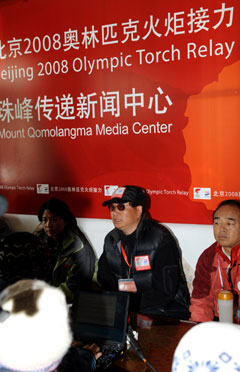QOMOLANGMA BASE CAMP, Tibet-- The Chinese climbers are beefing up for the ascent of the Olymic flame over Qomolangma, said Zhang Zhijian, spokesman of the Chinese Mountaineering Team, Friday at a press conference in the Qomolangma media centre at about 5,040 meters above sea level.
 Zhang Zhijian, spokesman of the Chinese Mountaineering Team, speaks during a press conference in the Qomolangma media centre at about 5,040 meters above sea level. Zhang admitted that Chinese climbers were gearing up for the ascent of the Olymic flame over Qomolangma. [Xinhua]
Zhang Zhijian, spokesman of the Chinese Mountaineering Team, speaks during a press conference in the Qomolangma media centre at about 5,040 meters above sea level. Zhang admitted that Chinese climbers were gearing up for the ascent of the Olymic flame over Qomolangma. [Xinhua] |
The relay, which started in Beijing on March 31, has been billed as the most ambitious of all time, with the "high point" set to be an ascent of Mount Qomolangma in May.
"It is difficult to climbe the peaks among the Himalayas as they are the tallest in the world, so our mountaineers have to adjust themselves to the high elavation by a spiral mode, that is to say, they are now shuttling within different camps at different altitude," said Zhang.
But Zhang refused to disclose which camp exactly those mountaineers are located for now.
According to earlier reports, the ascent route starts from the Base Camp with an altitude of 5,200 meters above sea level, then heads for the Advance Base Camp, known as ABC, at 6,500 meters. It then winds upwards the summit with help of three more camps respectively at 7,028, 7,790 and 8,300 meters before scaling the top of Mt. Qomolangma, which is known as Everest in the west.
There are 28 km between the 5,200-meter-high Base Camp and the 6,500-meter-high ABC, and from the ABC, there are 20 km to the top.
"The most important thing for the climbers to do is to get used to the altitude to ensure a successful ascent, so we can say that they have started the climbing as the traing and adjusting are part of the ascent," added Zhang, who declined to offer a breaking point between training and the real assault.
The first of these climbing training camps came into being in 2006 November when over 70 climbers got together separately in Beijing Huairou and southwest China's Tibet Autonomous Region before they joined each other in 2007 March for further training and selection.
Taking the torch up Qomolangma is one of the most technically challenging events Beijing has planned for the Olympics. Aside from the physical challenge of climbing the mountain, which straddles the border of Nepal and China's Tibet Autonomous Region, the torch had to be designed to burn in bad weather, low pressure and high altitude.
In 2007 May, a test-run went well as a mission of 17 Chinese climbers from the camp scaled the top of Mt. Qomolangma and finished the high-tech buring of the lantern and torch which were specially designed by a Chinese aerospace company to ensure that it will stay alight at high altitude.
After that, the newly formed Chinese Mountaineering Team has been preparing themselves for the ascent in the following time in Beijing, Yunnan Province and Tibet.
Zhang also announced the 50-member draft squad for the climbing, adding that he will detail the exact nember of the mountaineers who are involved in the historical feat.
According to him, the 50-man team is composed of mountaineers (torch bearers), coaches, officials and other working staff.
"The torch relay to Mount Qomolangma is a highlight of the whole relay, and it also represents the idea of Green Olympics, High-Tech Olympics and People's Olympics," Zhang said of the significance of the ascent.
"It will be the Olympic flame's first trip to the peak, so I think the torch relay on the summit will push the Olymic spirit to a new high."
The torch has returned to Chinese mainland at the beginning of May and continues through dozens of Chinese cities, with the first stop in Hong Kong on May 2.
The Olympic flame's trip to the top of Mt. Qomolangma will also be televised.
Beijing has promised in its bidding reports seven years ago that the holy flame of the Olympics will reach the peak. It will be the first time for the Olympic torch relay to be held on the 8844.43-meter mountain.
May and September are the most popular months for expeditions on Qomolangma.